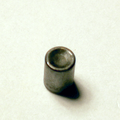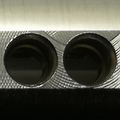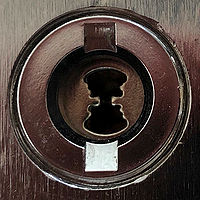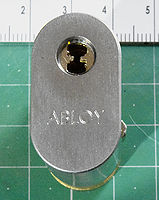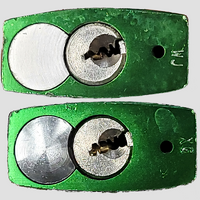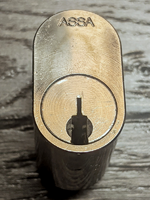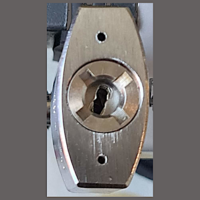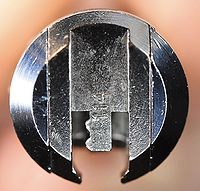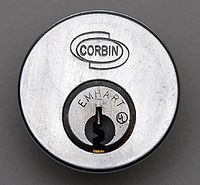Testing-mgsecure: Difference between revisions
| Line 8: | Line 8: | ||
==== Principles of operation ==== | ==== Principles of operation ==== | ||
The [[Goal|GOAL]] V18 utilizes [[dimple]] keys but functions the same as a standard [[pin-tumbler]] lock. The dimple key of the V18 has four cut depths for side pins and three, different cut depths for pins in the top row. The design offers 12 billion [[Differs|key differences]] when pinned with 18 active pins. The key is bitted on the sides and edges of the blade and is reversible. To open the lock, all active pin-tumblers -- across all three rows of pins -- must be aligned at the [[shear line]]. | The [[Goal|GOAL]] V18 utilizes [[dimple]] keys but functions the same as a standard [[pin-tumbler]] lock. The lock uses 21 chambers for pin-tumbler stacks. Eighteen or nineteen of those chambers each contain a set of keypin, driver, and spring. The dimple key of the V18 has four cut depths for side pins and three, different cut depths for pins in the top row. The design offers 12 billion [[Differs|key differences]] when pinned with 18 active pins. The key is bitted on the sides and edges of the blade and is reversible. To open the lock, all active pin-tumblers -- across all three rows of pins -- must be aligned at the [[shear line]]. ''(See also [[Pin-tumbler#Principles_of_Operation|Pin-tumbler, Principles of Operation]])'' | ||
Two of the chambers, one on each side, contain a sprung bearing or "click ball" to bias the core. This centering mechanism consists of a pin with a concave top which sits in the plug without entering the keyway and a ball bearing which sits in the bible. Centering pin stacks are also distinguishable by their shorter and wider springs. The core-biasing pins are always located one each on the left and right side of the lock, but the location within each row can vary. | |||
[[Master keying]] the V18 involves strategically removing one or more pins to create one or more mastered versions. <span style="color:#F00">''[what is the correct term?]''</span> GOAL utilizes inactive, dummy keypins and drivers that take the place of active pin stacks and do not interact with the key. Master key systems thus reduce the number of active pins. | |||
[[Master keying]] the V18 involves strategically removing one or more pins to create one or more | |||
<gallery> | <gallery> | ||
| Line 21: | Line 19: | ||
</gallery> | </gallery> | ||
GOAL utilizes a variety of [[security pin]]s to deter picking, the V18 uses a mix of thin and thick lipped mushroom spool drivers. Key pins are most often a combination of t-pins and tapered spools which are torpedo shaped to create overset traps. The plug also features overmilling to catch pins as they are lifted to shear. | GOAL utilizes a variety of [[security pin]]s to deter picking, the V18 uses a mix of thin and thick lipped mushroom spool drivers. Key pins are most often a combination of t-pins and tapered spools which are torpedo shaped to create overset traps. The plug also features overmilling to catch pins as they are lifted to shear. Additionally, the V18 uses two, smaller "ward pins" in the plug to restrict access to the keyway. | ||
Revision as of 15:45, 16 November 2022
This page being used for testing and development
Goal V18 description
The V18 is a dimple lock made by GOAL. Drilled for 21 pins, it contains up to 19 active pins and two core-centering pins. Pins are arranged in rows of seven on the left, top, and right of the keyway.
Principles of operation
The GOAL V18 utilizes dimple keys but functions the same as a standard pin-tumbler lock. The lock uses 21 chambers for pin-tumbler stacks. Eighteen or nineteen of those chambers each contain a set of keypin, driver, and spring. The dimple key of the V18 has four cut depths for side pins and three, different cut depths for pins in the top row. The design offers 12 billion key differences when pinned with 18 active pins. The key is bitted on the sides and edges of the blade and is reversible. To open the lock, all active pin-tumblers -- across all three rows of pins -- must be aligned at the shear line. (See also Pin-tumbler, Principles of Operation)
Two of the chambers, one on each side, contain a sprung bearing or "click ball" to bias the core. This centering mechanism consists of a pin with a concave top which sits in the plug without entering the keyway and a ball bearing which sits in the bible. Centering pin stacks are also distinguishable by their shorter and wider springs. The core-biasing pins are always located one each on the left and right side of the lock, but the location within each row can vary.
Master keying the V18 involves strategically removing one or more pins to create one or more mastered versions. [what is the correct term?] GOAL utilizes inactive, dummy keypins and drivers that take the place of active pin stacks and do not interact with the key. Master key systems thus reduce the number of active pins.
GOAL utilizes a variety of security pins to deter picking, the V18 uses a mix of thin and thick lipped mushroom spool drivers. Key pins are most often a combination of t-pins and tapered spools which are torpedo shaped to create overset traps. The plug also features overmilling to catch pins as they are lifted to shear. Additionally, the V18 uses two, smaller "ward pins" in the plug to restrict access to the keyway.
Larger gallery thumbnails (200px)
Sortable, formatted table
| Belt | Make | Model | Notes |
|---|---|---|---|
| Orange | ABUS | ABUS 55 | |
| Purple | Mul-T-Lock | Mul-T-Lock Interactive | |
| Brown | ASSA | ASSA d12 / ASSA P600 | |
| Brown | Goal | Goal D9 | |
| Red | Goal | Goal V18 / Goal GP | (< 14 pins) |
| Black | Goal | Goal Grand V | |
| Black | Goal | Goal V18 / Goal GP | (≥ 14 pins) |
| Black | Goal | Goal Z | (<2 standard drivers) |
